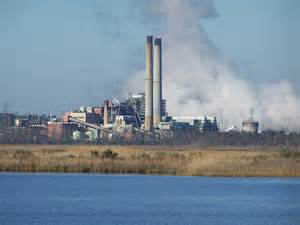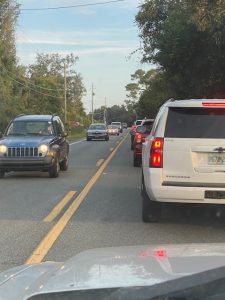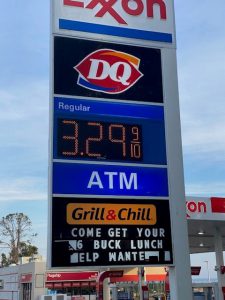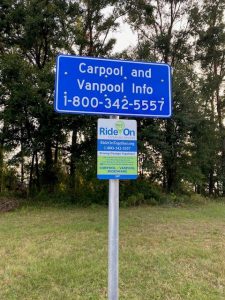In this series we have looked at where the concept of climate change came from and how climate has changed over the centuries. We looked closer at the changes over the last decade and what the most recent IPCC report is telling us. We also looked at how changes have impacted Florida and the panhandle specifically. Much of the news is concerning to many and the outlook for the rest of the century paints a picture of climate problems we will have to deal with. But hope is not lost. Based on the 2021 AR6 report, even if we stop all greenhouse gas emissions today, the sea will rise – we have missed that tipping point and will have to plan for that. But there are other areas where our communities can make changes to help turn this thing around. In Part 5 we will look at potential solutions and specifically focus on where individuals like you and I can make changes that can help.

Where do you start?
As G.T. Miller states in his book Living in the Environment1 it is going to be tough. It is a global problem and will take many nations to agree to make things happen. We know how hard that can be. It is also a political problem, and we know that can be hard as well. It is also affecting some regions of the planet more than others and thus some will be more concerned and ready to act, while others do not see the need to spend resources on the issue. Miller states there are two basic plans of attack on this – (1) reduce greenhouse gas emissions, or (2) try and mitigate the impacts.
During the 1970s Dr. William Rathje developed a program at the University of Arizona called Garbology. One of the objectives of the program was to determine what humans throw away in order to determine what the “big players” were in reducing solid waste going to the landfill1. They were able to develop a pie chart showing what items made up the material we call garbage and then developed a plan to reduce those “big players”. Let’s take the same approach with reducing greenhouse gases. What are the sources of these gases? Who are the “big players” so that we know where to direct our efforts to significantly reduce emissions and curtail some of the possible problems predicted by the models?
According to a 2021 EPA report, carbon dioxide (CO2) makes up 76% of the global greenhouse gas emissions2. This would be an obvious gas to target significant reductions. 86% of the carbon dioxide comes from the burning of fossil fuels, a more specific target for reduction and a good starting point.
| Percentage of Greenhouse Gas Emissions | Gas | Source |
| 65% | Carbon dioxide (CO2) | Fossil Fuels |
| 16% | Methane (CH4) | Waste, Biomass energy |
| 11% | Carbon dioxide (CO2) | Deforestation, Agriculture, and Soil degradation |
| 6% | Nitrous oxide (N2O) | Fertilizer use |
| 2% | Fluorinated gases | Industrial processing, Refrigerators, and some consumer products |
Source: U.S. Environmental Protection Agency
So, where are fossil fuels being burned?
Where can we begin to discuss reductions there?
The same US EPA report breaks down the economic sectors where greenhouse gases are being produced on a global scale. A second report focuses on those same sectors but from the United States3. The table below compares these two.
| Global Economic Sector | Percent | U.S. Economic Sector | Percent |
| Electricity and Heat Production | 25% | Transportation | 29% |
| Agriculture and Forestry activities | 24% | Electricity and Heat Production | 25% |
| Industry | 21% | Industry | 23% |
| Transportation | 14% | Commercial and Residential use | 13% |
| Other Energy Sources | 10% | Land Use and Forestry activities | 12%1 |
| Agriculture | 10% |
Source: U.S. Environmental Protection Agency
noted that total my not round to 100% due to independent rounding
Comparing the greenhouse gas emissions of U.S. economic sectors to those of the world shows a few things.
- Electricity and heat production is a major producer of GHG and a good target for reduction.
- Transportation is a larger problem in the U.S., in fact it is the number one problem.
- Agriculture and forestry are larger problems on the global scale, less of one in the U.S.
- Commercial and residential use is a larger problem than agriculture and forestry in the U.S., it was not even reported on a global scale.
Now we know who the “big players” are. Can we do anything about these?
Reducing emissions from electricity and heat production will have to come from our leaders. At the time of this writing, the United Nations Climate Summit is going in Scotland and much discussion about this is going on. China, Russia, and India are all concerned about reducing GHG from coal powered plants. This is understandable being that this is the major source of energy for those nations. However, the negative impact of burning coal on the climate is serious and cannot be ignored if the world is serious about reducing, or eliminating, the long-term impacts of climate change. So, the move away from coal is a good start.

Photo: Flickr
The EPA reported in 2019 that United States has seen a decrease in greenhouse gas emissions primarily due to a decrease in energy use and the decrease in the use of coal – showing it can be done3. The United States is discussing reducing the use of coal even further, but not all in congress support this – primarily those who represent states where coal mining is a large industry. But again, the negative impacts of burning coal are there and, if the world wants to “turn this thing around”, we will need to consider doing this. Again, there is little the citizen can do to make these changes other than selecting leaders who are willing to. It is in their hands.
The transportation issue is different… we can make a difference here.
In the U.S. transportation produces 29% of the greenhouse gas emissions, #1. It is only 14% of the problem worldwide. Americans love their cars. We drive everywhere. Most Americans live at least 25 miles from where they work, many live much further, some actually live in a different state. Being work, most of these drivers are traveling alone, carpooling is not a common practice, and mass transit is not available in many communities. So, we sit in traffic jams every morning and evening trying to get to the places we want, and need, and complain of the congestion, wishing the local government could improve traffic flow. One of the reasons we have this problem, and other parts of the world do not, is how we design our cities.

Photo: Rick O’Connor
Some city planners argue the best way to reduce the transportation issue is by compact development. This is a plan that would have residents live within walking or biking distance of everything they need – home, work, stores, etc. Our ancestors lived this way primarily because they had to, they did not have cars. The wealthy, who had horse and carriage, could live outside of town and ride in when they wanted.
This desire to live outside of the city in more open space could be used in another form of urban development that could still reduce the transportation problem – satellite development. In this method, residents would live in suburb areas that were connected to the urban workplace by mass transit. Imagine living in a suburb where you went to the rail station, climbed on, and traveled over greenspaces (supporting forest and pasture lands) to the urban work area. There are many cities in the U.S. who have this type of system in place, but few travel over greenspaces – they mostly travel over other suburban developments.
However, this would generate crowds at the terminal and the stress that comes with it. It would make it harder to “stop by the store” on the way home – though the stores would be within walking distance in the residential “satellite” area. Walt Disney promoted this idea when he was planning Epcot and used the monorail as an example of how it could be done.
But we love our cars… so, another plan would be what is called corridor development. Here, people would live in the residential satellite suburbs but rather than mass transit into the city, there would be a “freeway” for cars to use. Freeway in this sense meaning nothing but highway… no traffic lights, no stores, nothing the impede traffic until you get there. Think in terms of our interstate system. There are many examples of this design around the country. Even here close to home, highway 98 was diverted around Destin to avoid traffic jams. The idea was there would be a clear road around if you were traveling through. But as we will see, in most cases, this did not work.

Photo: Rick O’Connor
In most cases we plan a corridor design but along the “freeway” route we build new residential developments – they want stores closer and so strip malls and other commercial developments spring up – these residents and businesses need access to the “freeway”, so traffic lights go up and now the city has basically moved away from the central hub into the suburbs forming what we call a megalopolis. I bet this scenario sounds very familiar. It is happening everywhere – even here in the Pensacola area.
Urban sprawl is a big problem and only makes the transportation issue a larger one. G.T. Miller Jr. mentions that urban sprawl is occurring because
- There is affordable land to do so
- We have automobiles so we can function in the design
- Gasoline is cheap
- And we do not plan our cities well
So, we live in a car dominated society – traveling everywhere – usually alone.
Can we do anything about this?
Many scientists and economists believe the only way to reduce the transportation problem is to make it expensive to use. It is believed that making gasoline more expensive would force many to change their driving habits. Currently gas prices are moving towards $4.00 / gallon. We have seen this before and the driving practices did not change much. Some economists believe you will not see such changes until gas reaches $5.00 or $6.00 / gallon – a price many other developed nations routinely spend. It will be interesting to see.

Photo: Rick O’Connor
Another idea on the cost side is a gasoline tax to cover the estimated harmful costs of driving. The funds from such taxes could be used to develop mass transit systems, bike lanes, and sidewalks. This is occurring in other parts of the world but would probably not work in the United States. Miller gives three reasons why it would be a hard sell in the United States.
- There would be opposition to any tax.
- Fast, efficient, reliable, and affordable mass transit systems and bike lanes are not widely available in most U.S. communities
- The way our communities are designed… we need cars
Other suggested financial methods would include raising parking fees within the city, and more toll roads.
But while we wait and see where gas prices will go and when people will make changes in their driving habits, is there anything else we could do?
Yes…
Carpooling has been suggested since the 1970s. It does occur but has not caught on as many had hoped. Within our community here in Pensacola there are several “park and ride” parking lots and there usually cars in them.

Photo: Rick O’Connor

Photo: Rick O’Connor
There has been an increase interest in hybrid and electric cars in recent years. One concern for electric was the ability to pull heavy loads, something Americans will require. In just the past year one major auto maker began promoting an all-electric truck they assure has the pulling power of a similar size gas powered truck. One colleague of mine recently bought an all-electric jeep which he assured me has plenty of power to pull. More electric charge stations are appearing in local communities, and it seems this is an option for many.
It was also noted in the EPA report that changing our driving habits (i.e., fast starts, incorrect tire pressure, etc.) does make a difference. I know we have all seen the driver who is speeding – darting in and out of traffic only to be at the same stop light with all others in the end. So, changing HOW we drive can help as well.
As mentioned, agriculture and forestry are not as big of an issue in the U.S. as it is on a global scale. There are numerous BMPs farmers can use to reduce their carbon footprint and restore the natural carbon-sequestration. Most not only help with reducing GHG but save the farmers money. There are financial incentives for them to participate in these BMP programs – and so many farmers are using these BMPs. But none-the-less there are things we can still do in this area.
- Support local farmers who are participating in BMP programs by purchasing their products where/when you can. On a global scale the negative impacts of agriculture are increasing. You may have to do a little homework to see where our farmers are selling their products, but it is good to support their efforts.
- Plant a tree… though our forestry industry is making improvements, many communities are clearing land to expand development. Many of these developments are clearing ALL of the trees and putting few back afterwards. Planting a tree not only helps sequester carbon it has been found that shade from trees can lower internal house temperatures up to 10°F, saving heating and cooling costs as well as the energy needed for these1.

And then there is commercial and residential energy use. Something that did not even make it on a global scale.
How can we reduce energy use at home and at work?
There are plenty of ways and we need to consider them. According to the EPA report, energy use in the residential and commercial sector is increasing, not decreasing3.
Let’s begin with smart buildings…
Our home was struck by lighting in 2013 and we rebuilt using as many energy efficient methods as we could. Spray foam insultation, better windows, energy efficient appliances, LED lighting, metal roof, and setting the thermostat smarter have all worked well for us. We are typically billed less than $200 per month for our electricity – and there is more we can do. Your local utility company, and your county extension office, can give you numerous tips on how you can save energy in your home or office.
The 2019 EPA report suggests that greenhouse gas emissions are increasing in the areas of transportation, residential and commercial use, and some agriculture practices. But they are decreasing in energy production, industrial processing, and forestry activities. So, we know we can do this. We just need to step up and do it.
References
1 Miller Jr., G.T., S.E. Spoolman. 2011. Living in the Environment; Concepts, Connections, and Solutions. 17th edition. Brooks and Cole Publishing. Belmont CA. pp. 674.
2 Sources of Greenhouse Emissions. 2021. Global Greenhouse Gas Emissions Data. United States Environmental Protection Agency.
https://www.epa.gov/ghgemissions/global-greenhouse-gas-emissions-data.
3 Sources of Greenhouse Emissions. 2019. U.S. Greenhouse Gas Emissions Data. United States Environmental Protection Agency.
https://www.epa.gov/ghgemissions/sources-greenhouse-gas-emissions
 0
0
